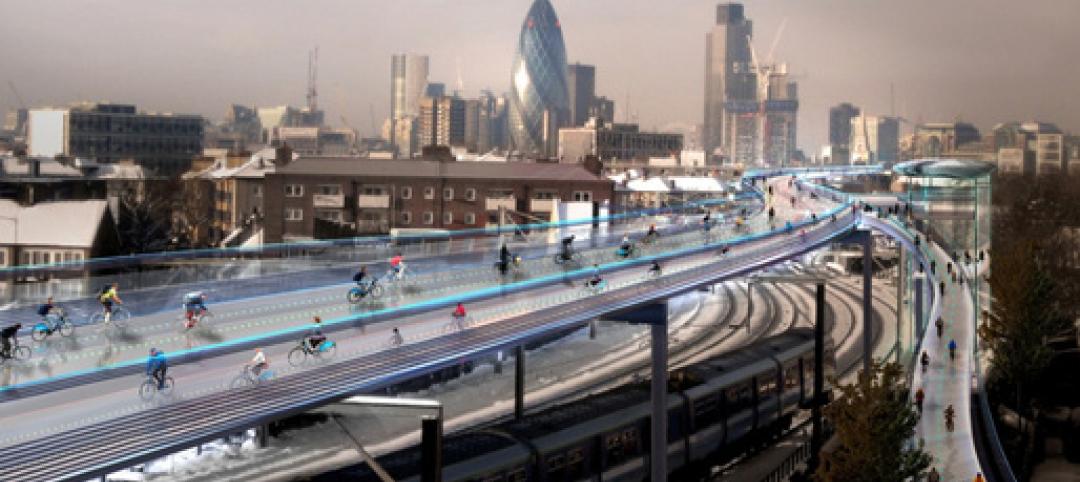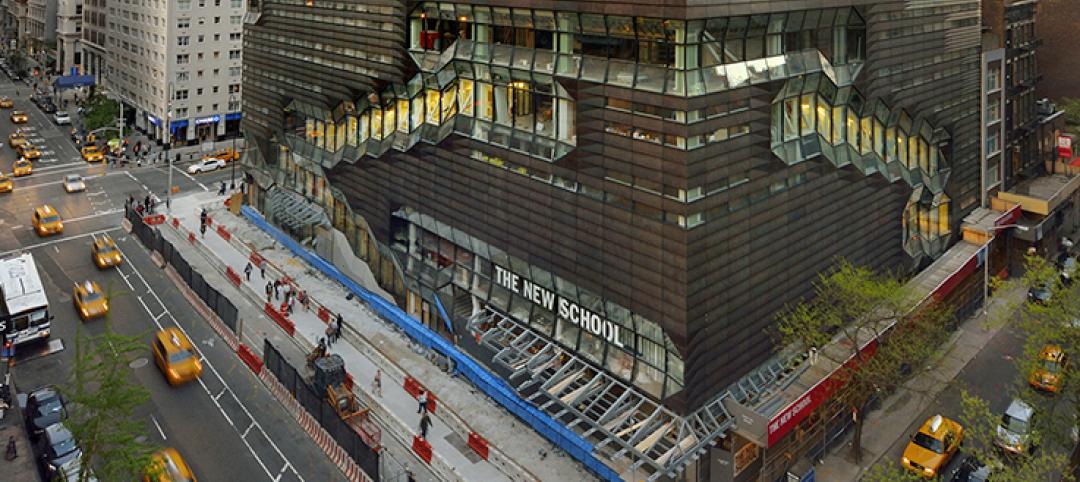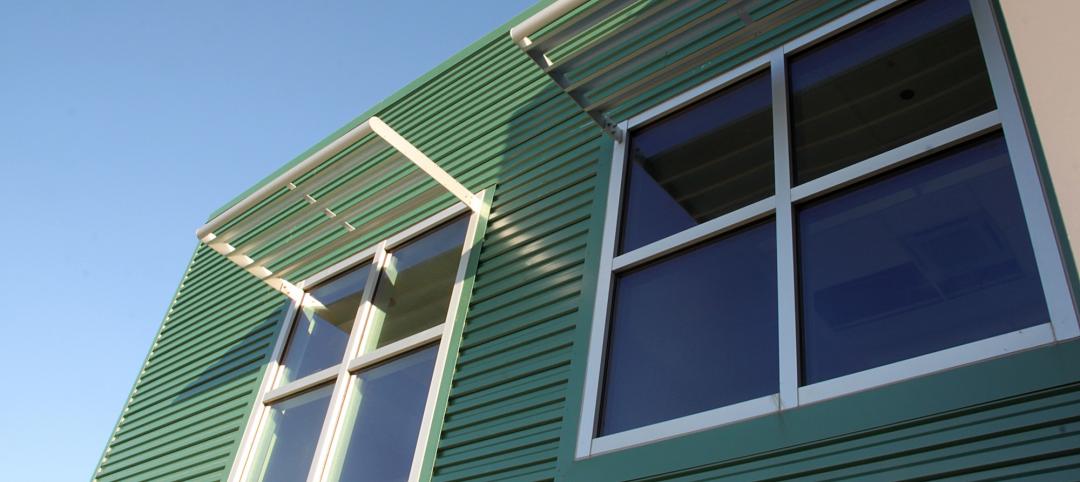In a 1986 Harvard Business Review article, “The New New Product Development Game,” Hirotaka Takeuchi and Ikujiro Nonaka observed that in order to excel in a fast-paced market, companies should emphasize speed and flexibility in product development. They advocated shifting from a linear “relay race” approach to an agile “rugby” approach in which multidisciplinary teams work together on a project from start to finish.
Agile work is an umbrella term used to describe a broad project management philosophy. It is one among many methodologies that contribute to an organizational approach. Although IT developers and start-ups popularized the concept of agile work in recent years, companies have been utilizing methods we now classify as agile for almost as long as the modern office has existed. This is not a new concept, but rather one that is being recycled and reinterpreted for today’s modern, technology-focused future.
Takeuchi and Nonaka adopted one specific component of the game of rugby, the scrum, to further define their method of agile work. In a rugby scrum, players pack closely together with their heads down and bodies interlocked in an attempt to gain possession of the ball. Each player contributes a unique set of skills towards a common goal.
This analogy has been further refined over time by those who have adopted the agile method of work. In the 2017 edition of “The Scrum Guide,” by Ken Schwaber and Jeff Sutherland, the agile team (or scrum) is a highly adaptive, purposefully small team that operates under defined rules, roles, events, and artifacts in order to develop, deliver, and sustain complex and innovative solutions. Teams are built on the three pillars of 1) transparency, 2) inspection (which we are labeling introspection), and 3) adaption, requiring members to embrace the values of commitment, focus, openness, respect, and courage.
As observed by Takeuchi and Nonaka, successful agile teams are intentionally built to include diverse points of view and purposefully eliminate a sense of hierarchy. In a follow-up publication, “Embracing Agile,” Rigby, Sutherland and Takeuchi acknowledge the scrum/agile method is an investment that requires training, behavioral change, and new tools.
HOW THE SCRUM APPLIES TO TODAY'S WORKPLACE
In 2021 we are returning to a workplace that was designed to support an obsolete way of working. As companies move toward a hybrid model of virtual and in person work, they are investing in workspace designs that support a more resilient, technology-dependent workforce comfortable working in pods and scrum-like networks.
Accelerated by the pandemic, the rise of collaboration, and a rapidly increasing reliance on technology, more organizations are moving toward agile methods. As everyone now has an individual work seat at home, the physical office environment’s primary value comes in supporting the team, ideally through Schwaber and Sutherland’s three pillars: transparency, inspection and adaptation.
The challenge comes in providing space that can uphold the three pillars, create equity, encourage conversation, and reinforce team values while still providing the flexibility to accommodate individual skill sets and ways of work. In a post-pandemic world, these spaces should also focus on technologies that allow remote team members to interface with their in-office counterparts in a way that ensures them a seat at the table.
TRANSPARENCY – SETTING THE COMMUNAL TABLE
Transparency across the agile team manifests through space when individual work areas are centrally located, often at a communal table, thus allowing for fluid exchange of ideas. The community that forms from working together also leads naturally to leveling the playing field in terms of hierarchy, which helps to foster a sense of team territoriality and belonging.
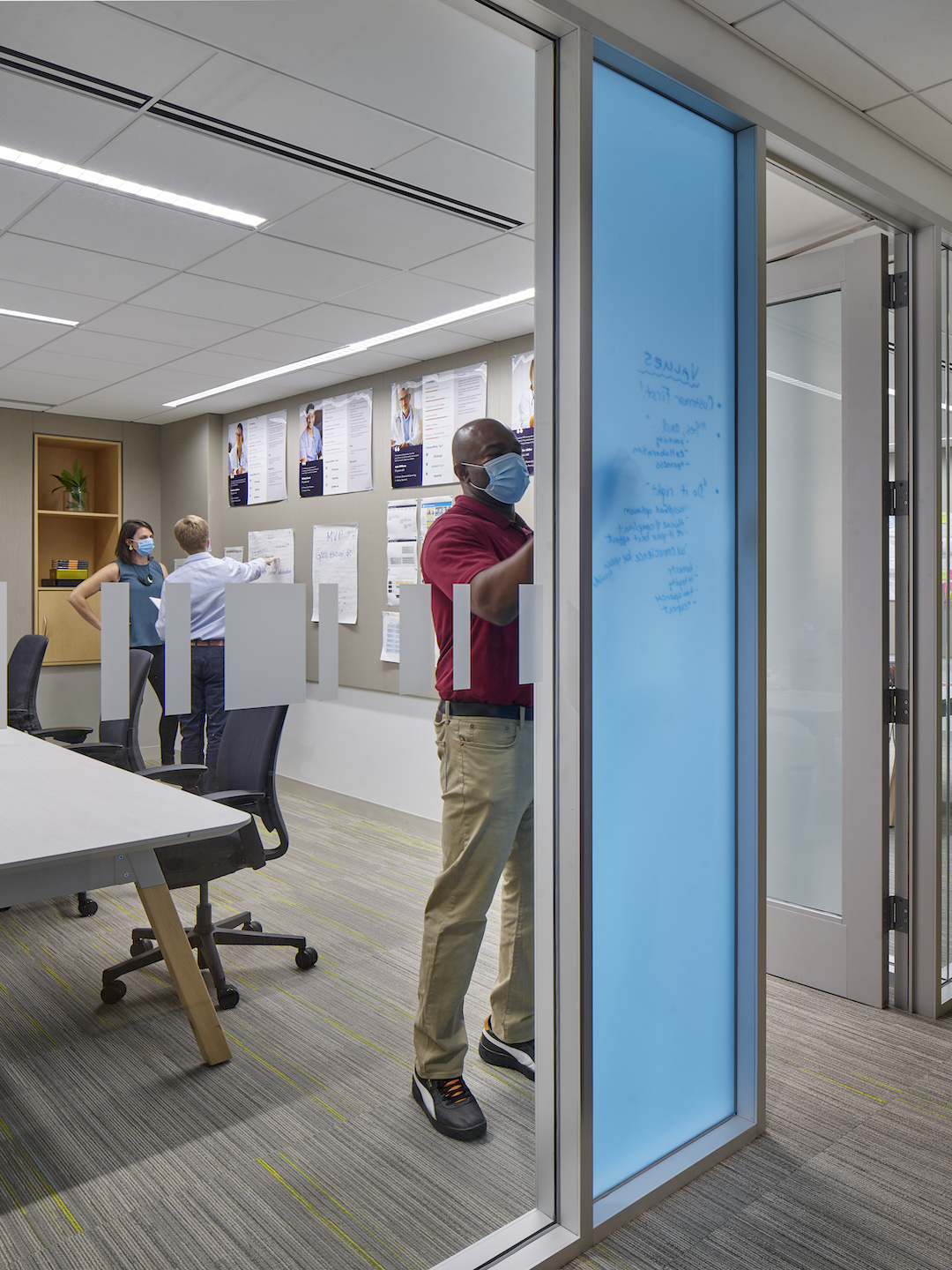
The scrum framework prioritizes visibility. Transparent and translucent glass can balance collaboration, privacy, and access to natural light. Photo: © Halkin Mason Photography
Creating this team area as a safe place to experiment, make mistakes, and adapt outside of the watchful eye of management is a key component of agile work.
A space that can be physically closed off and made private empowers the group to manage their own environment as appropriate for each phase of development.
Anticipating and building in effective plug-and-play technology increases transparency across the in-person and remote team.
Providing literal transparency through glass walls and other architectural solutions can help the team better control their environment, sharing or closing down when needed.
INTROSPECTION – CREATING SPACE FOR HEADS-DOWN WORK
Providing settings for introspection – or in the language of the scrum framework, inspection – enables moments of solitude to support neurodiversity, which is essential to innovation.
Spaces that support “heads down” work are often at odds with a team room setting. Providing focus rooms and small break-out spaces, either within the team space or adjacent, allows members room to review progress and concentrate on their specific contribution to the team. It allows for smaller groups to break off to develop ideas independently before introducing them to the team at large.
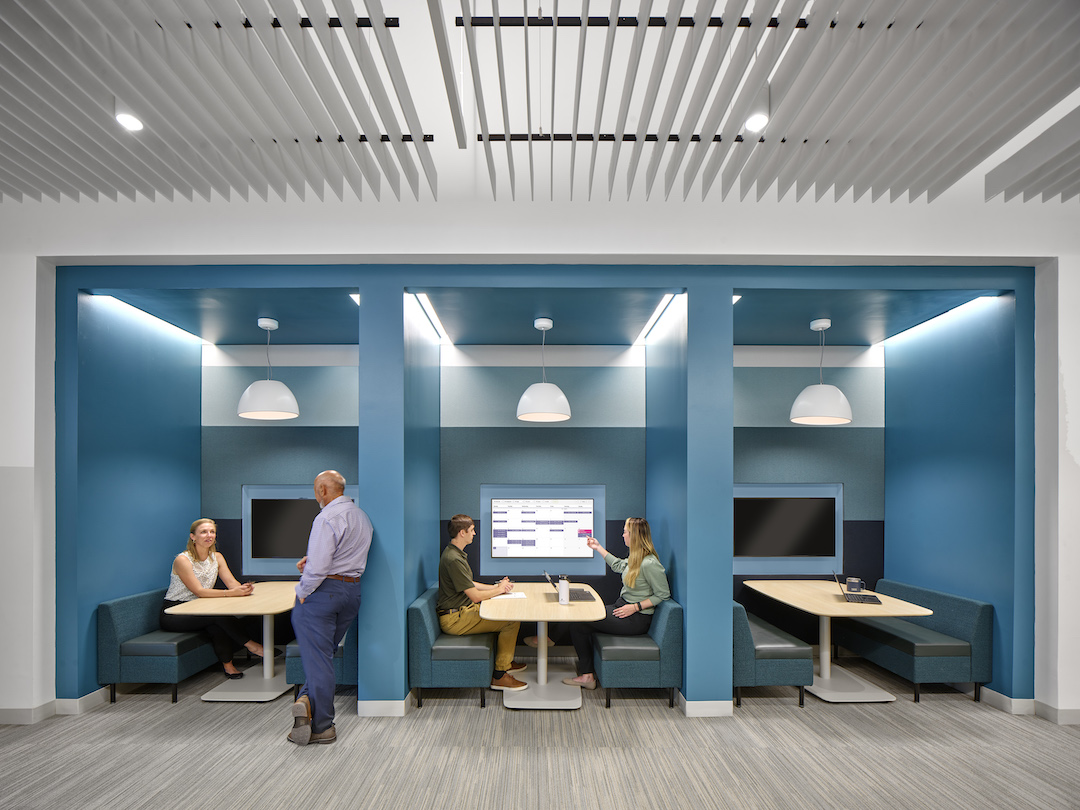
Collaboration booths with access to AV technology enable introspection and contribute to a neurodiverse environment. Photo: © Halkin Mason Photography
Giving people autonomy to change their work setting, even for short periods of time, allows them to recharge and refocus. Providing quiet spaces accommodates team members who are sensitive to the stimuli of a typical open office environment.
ADAPTATION
One of the most significant benefits of working in an agile team is that it builds resiliency in members. The cyclical nature of the scrum process – the frequent check-ins and realigning of values and goals – compel teams to adapt quickly to change. If this was not a valued attribute in a pre-pandemic world, it certainly is now.
Agile workspace designs accommodate growth and enable adaptation. Supportive technologies and spatial features such as movable furniture and wall surfaces allow innovation to literally be seen.
As we move into a new paradigm of work, we need to evaluate what won’t change – core values, basic human needs, and common infrastructure – and assume everything else will.
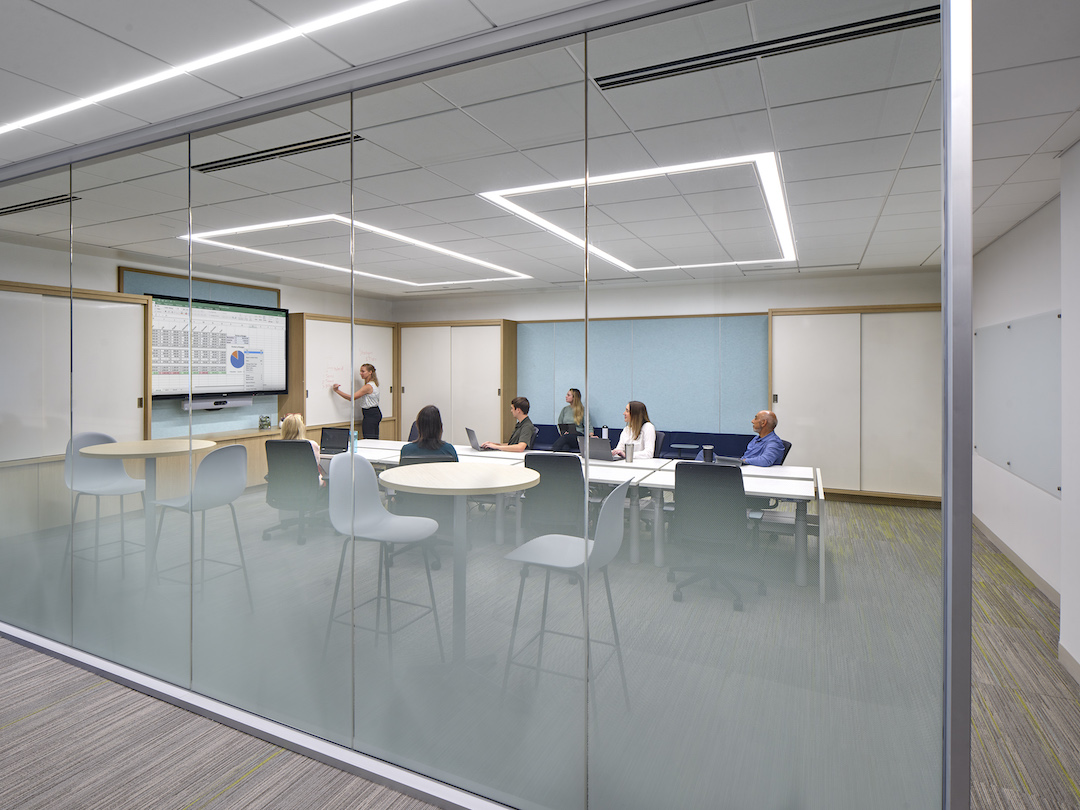
Continuous improvement relies on the ability to adapt to change. Adjustable height tables, movable furniture, writable surfaces and pin-up space maximize adaptability. Photo: © Halkin Mason Photography
In a recent Steelcase poll, employees in the U.S. ranked isolation, decreased engagement, and the speed of decision-making as the top three challenges of remote work.
Agile team spaces are essential components of the future office landscape and have the ability to ensure that teams feel supported by their work environment.
About the authors
Katherine Ahrens, LEED AP, is an Associate Principal and Interiors Studio Lead at Ballinger. Kate Hallinan, NCIDQ, is an Associate at Ballinger.
Sources
Takeuchi, Hirotaka and Ikujiro Nonaka,“The New New Product Development Game,” Harvard Business Review January 1986.
Schwaber, Ken and Jeff Sutherland. The Scrum Guide – The Definitive Guide to Scrum: The Rules of the Game. Ken Schwaber and Jeff Sutherland, 2017 at: https://scrumguides.org/docs/scrumguide/v2017/2017-Scrum-Guide-US.pdf.
Rigby, Darrell K., Jeff Sutherland, and Hirotaka Takeuchi, "Embracing Agile: How to master the process that’s transforming management," Harvard Business Review, May 2016.
Related Stories
| Jan 3, 2014
Norman Foster proposes elevated bikeways throughout London
Called SkyCycle, the plan calls for the construction of wide, car-free decks atop the city's existing railway corridors.
| Jan 3, 2014
World’s tallest vegetated façade to sprout in Sri Lanka [slideshow]
Set to open in late 2015, the 46-story Clearpoint Residences condo tower will feature planted terraces circling the entire structure.
| Dec 31, 2013
Top 10 blog posts from 2013
BD+C editors and our contributors posted hundreds of blogs in 2013. Here's a recap of the most popular topics. They include valuable lessons from one of the first BIM-related lawsuits and sage advice from AEC legend Arthur Gensler.
| Dec 31, 2013
BD+C's top 10 stories of 2013
The world's tallest twisting tower and the rise of augmented reality technology in construction were among the 10 most popular articles posted on Building Design+Construction's website, BDCnetwork.com.
| Dec 30, 2013
Calatrava facing legal action from his home town over crumbling cultural complex
Officials with the city of Valencia, Spain, are blaming Santiago Calatrava for the rapid deterioration of buildings within its City of Arts and Sciences complex.
| Dec 30, 2013
Survey: Number of licensed architects grows in 2012-13
A survey by NCARB shows that there are 105,847 registered architects in the U.S., up slightly from the organization's 2011-2012 survey.
| Dec 29, 2013
7 ways to make your firm more efficient
In a CEO.com post, Andrew Miller, president of ACM Consulting, shares the seven organizational efficiency strategies he encounters most frequently as he works with corporate executives to boost their performance.
| Dec 24, 2013
First Look: Calatrava's Sharq Crossing in Doha, Qatar [video]
The government of Qatar has released details of Sharq Crossing, a massive infrastructure project designed by Spanish architect Santiago Calatrava.
| Dec 23, 2013
MBI commends start of module setting at B2, world's tallest modular building
The first modules have been set at B2 residential tower at Atlantic Yards in New York, set to become the tallest modular building in the world.
| Dec 23, 2013
First Look: KPF's dual-tower design for Ziraat Bank in Istanbul
Kohn Pedersen Fox Associates (KPF) is designing a new headquarters for Turkey’s largest and oldest financial institution, Ziraat Bank, in a modern, suburban district of Istanbul.



